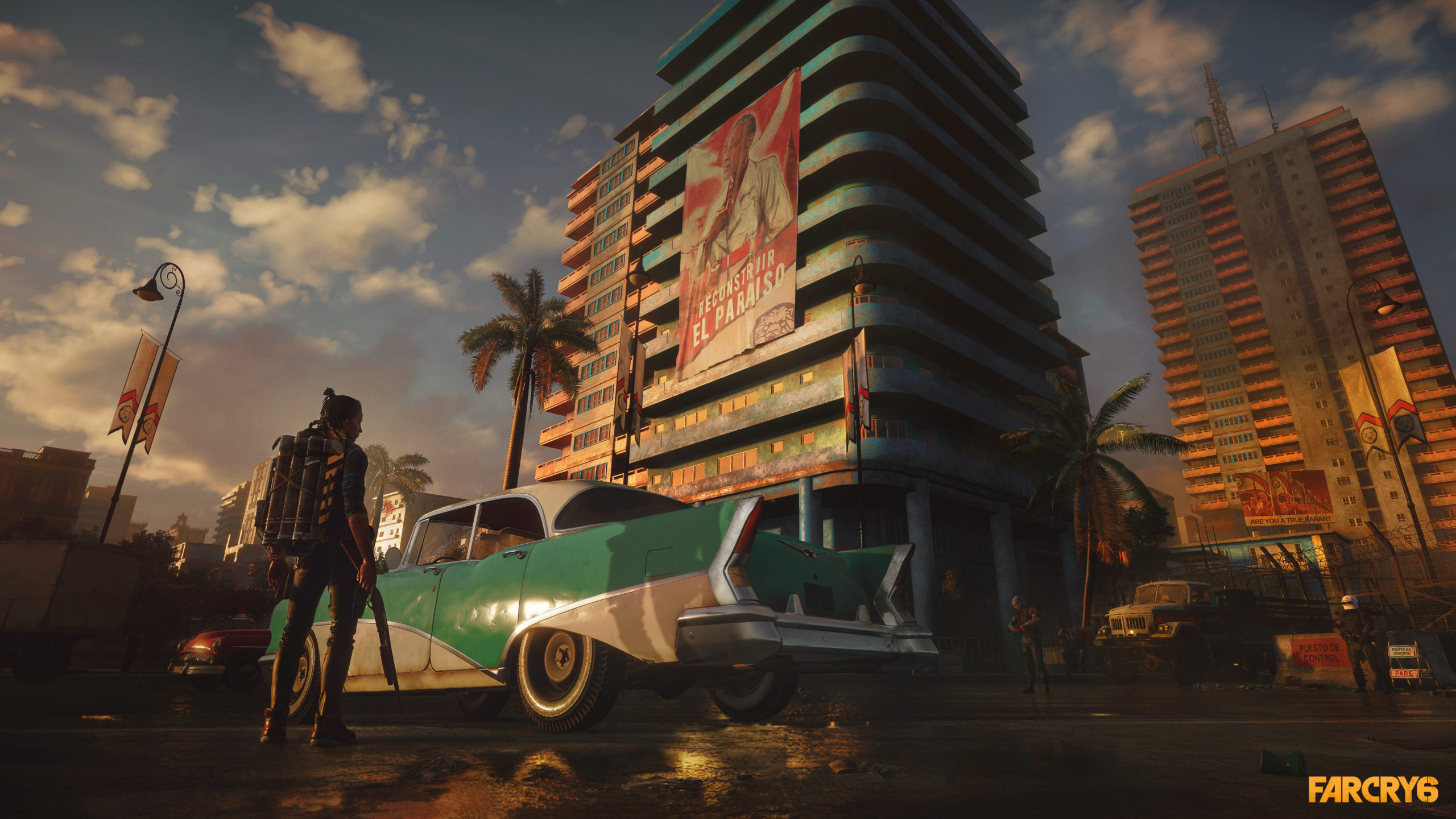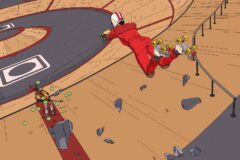When it comes to sandbox first-person shooters and open-world action-adventure video games where you can shoot, destroy, and/or blow up just about anything, few names top Far Cry.
Ever since setting the bar for the genre in 2012 with Far Cry 3, the games have gone in a wide variety of directions — from the neon ‘80s movie of the Blood Dragon expansion to the prehistoric spinoff Primal to the rural midwestern slaughter of Far Cry 5. But no matter the setting, a few things are always true for Far Cry games.
Players know they’re going to get dozens of hours worth of high-octane action, all while set in a beautiful surrounding and a surprisingly deep cast of characters. Each game is like an extremely violent location to a new locale, and you occasionally meet a questionable person that you’ll never forget (like Michael Mando’s Vaas Montenegro).
In that sense, Far Cry 6 looks no different. With a cast headlined by Giancarlo Esposito (doing what he does best by playing a well-dressed ruthless-yet-formal villain, dictator Antón Castillo) and a setting on the fictional Caribbean island of Yara, the latest entry in one of Ubisoft’s most iconic series will undoubtedly please the millions of existing fans while drawing in some new ones.
But beyond just serving as a blood-soaked romp, the Far Cry 6 team wants to show Latin American culture in both a positive and accurate light. To provide that appropriate representation, Audio Director Eduardo Vaisman enlisted fellow Brazilian Pedro Bromfman (Narcos, RoboCop, Elite Squad) to compose the score for the game and develop the unique and authentic soundtrack of Yara.
SPIN sat down for an international video chat with Vaisman, Bromfman, and Associate Producer Nicola Jones to chat about Far Cry 6 and building up the sounds of Yara.
SPIN: Considering that Far Cry 6 has a whole new location, new consoles, new characters, new environments and more, what was it like to musically build the world of Yara from the ground up?
Eduardo Vaisman: I think Far Cry as a brand offers a very wide spectrum of things to do. It presents not only the player, but also the developer a sandbox of opportunities to dive into. You have the sounds and music of a believable world on one side, and then the gameplay score that fits in the player’s behavior — but is also entangled in the world itself. From a sound standpoint, that has to be present not only in the music, but in the ambiance, in how people talk, the words they use, how they express things, the sounds of the vehicles, the sounds of the weapons. Everything is a small brushstroke to paint that world.
Pedro Bromfman: What was interesting when you’re talking about building the world is that I’ve been working on Far Cry 6 for over two years now, so I’ve been involved from the very beginning. When I was first brought in, they had a storyline and obviously the world somewhat, but that changed a bit over time. I felt like everything they had — which wasn’t much in the beginning — was feeding my process, but also the music we were creating and collaborating on was also feeding their process. Every time a new piece of music got into the game, I would hear from the designers or the producers. It’s really been the ultimate collaborative experience because we’ve been together for two and a half years, and everything has been ideas bouncing back and forth.
I know many composers weren’t too affected by the pandemic, but considering that Far Cry is such a massive title and a huge operation, how was the collaboration of it all through the last 18 months?
Nicola Jones: It’s so new to globally go through something like this together. Every person in every country had to go through this at the exact same time. We were working with actors in L.A., Montreal, here in Toronto, and several other places, so we had to figure out how to do any of it with integrity and safety. If our actors didn’t feel safe coming into the studio, then we weren’t going to ask them, we’d just make sure that we have remote ways of doing it. Our voice design team were heroes, because they put together their own video tutorials from their houses to guide the actors. “Here’s how you plug into an interface.” “Here’s how to do this.” They were being engineers from thousands of miles away, and they didn’t have to do that. They went that extra mile because we all know what it’s like trying to connect like this at a distance. Some days, I don’t know how we did it, but we got through it.
Now, there’s no shortage of games set in Latin America and the Caribbean, but I know you were really looking to provide some authenticity and appropriate representation with the island of Yara. What was that like to work on this setting that’s obviously close to home for you?
Bromfman: I had just done a teaser for another game with Simon Landry [Music Supervisor for Ubisoft Montreal] and he mentioned “There’s a game that takes place on this Caribbean island, and I want to pitch your name because you may be perfect for it.” I had no idea it was Far Cry or what it was even about, but I sent some music in and they said “You’re perfect for it.” I think one of the initial videos that I had received even had some of my music from Narcos in the background. I didn’t realize that it was my music at first, but it felt like it was meant to be from the beginning. Of course, I think my being from Brazil and very experienced with Latin American music and Caribbean music was a big point in bringing me in. From there, it was the challenge of doing something new in the score. There’s diegetic music. There’s music playing in the streets that is very Caribbean. There’s traditional Latin American music — the way it’s supposed to be — but we wanted to infuse it, have that be the base of everything, and then create a lot more on top of it to differentiate the different regions. It was really tremendous, and we had a lot of time to do it. It was a process of experimenting and finding the right sound for Yara and for the characters. It was really fascinating.
Vaisman: I knew I needed to think about the soundtrack of this game right from the beginning of the project. I was also talking to Simon [Landry], and he had already talked to Pedro. I said “Do you mean that I can get the Narcos guy in my game? Really? OK, yeah, let’s go!” We started with a brief period of just telling Pedro what the story was about so he could explore the different pillars of the game and the main characters, and then he created a suite of different songs and themes that could be the seed for whatever came next. I remember when he presented the “Revolution” theme at the beginning, and even now the hair on the back of my neck stands up just thinking about it. The team was like “Holy smokes, this is magic!” They actually timed the opening of the game around the song that Pedro did because it was just perfect. We just had to adjust the picture to the music, because the theme was done.
Obviously Far Cry is known for its high-action sandbox qualities, but the latest entry is really putting more emphasis on a serious narrative as well. Considering that Pedro’s background is largely in action-packed dramatic films, did you all see that as an opportunity to really let the music drive the emotion of the narrative as well?
Bromfman: I felt right at home. This is the third video game I’ve been involved with, so I have some experience, but the part that was more challenging to me was how to make the missions interesting. You need a piece of music that’s two minutes long but can loop indefinitely and vary intensity. It needs to work whether you’re fighting two enemies or 20 enemies. Telling the story and working with the cutscenes is the easier part for me. The narrative director was just feeding me the stories, backstories, and the future stories of all the characters, so I felt like I knew this world like the palm of my hand. I knew all the characters, the themes they needed, and the music they needed to tell their story. Once we came to the cinematics — which was the very end of the process — it was a piece of cake. I’d been working on this music for probably a year and a half, and it was just a matter of doing what I know how to do, like shaping the music to the scenes. That’s very much my cup of tea.
Vaisman: I knew from the beginning that we were working with a storyteller in Pedro. So that was also the easiest part for me. I knew he understood the drama and the motives of every cinematic reaction. So I said “OK, just do your thing.”
Jones: There was also influence on the narrative side. It’s like when you hear the actor’s voice for the first time, you then start to write in that voice. So when we first heard the themes of these characters and these regions, we’d then write in that voice. It really was this relationship that worked both ways, and I still remember when Pedro played that theme for the first time. We’ve got this massive meeting room where you can fit hundreds of people, and I remember they put the Far Cry logo on the screen and played the theme, and everybody shut up — which is rare for our development team. It was just silent. Everyone had this moment of “Oh my God, this feels like Far Cry now. Let’s go and do this!”





